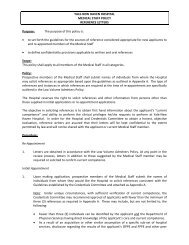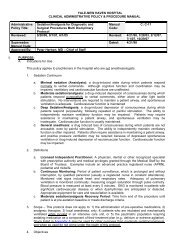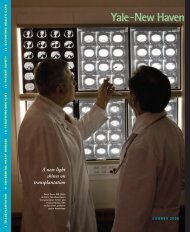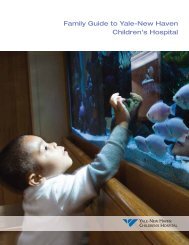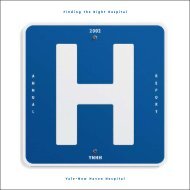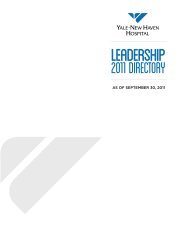Medical Staff Education Reading Materials - Yale-New Haven Hospital
Medical Staff Education Reading Materials - Yale-New Haven Hospital
Medical Staff Education Reading Materials - Yale-New Haven Hospital
You also want an ePaper? Increase the reach of your titles
YUMPU automatically turns print PDFs into web optimized ePapers that Google loves.
Checklist Elements<br />
• Intra-procedure<br />
Maintenance of Sterile field<br />
Consider obtaining help after 3 unsuccessful attempts<br />
Use of ultrasound guidance as appropriate<br />
Removal of guide wire<br />
• Post Procedure<br />
Application of a sterile dressing (including “Biopatch” which is a<br />
chlorhexidine based dressing)<br />
Imaging (if necessary)<br />
Clean and return equipment (ultrasound, cart etc)<br />
Complete checklist and submit to floor/ICU manager<br />
Complete procedure note<br />
• Nurses (and other observers) are empowered to stop the<br />
procedure if there has been a breach in sterile technique or<br />
any non-adherence to the checklist.<br />
Additional Key Points<br />
• Practice does vary – infants and newborns should not have skin antisepsis<br />
with chlorhexidine (iodine antisepsis alternative for rare cases of chlorhexidine allergy)<br />
• Many catheter infections are related to maintenance rather than insertion<br />
therefore daily surveillance with early removal of lines is essential.<br />
• Blood cultures should always be drawn peripherally – contamination rate<br />
(false positives) if drawn through CVAD is substantial.<br />
• Change of CVAD over a wire is not recommended and should be reserved<br />
for specialized situations (Due to inability to obtain other access (e.g.<br />
stenotic vessels) or emergencies).<br />
• Consider antibiotic/antiseptic coated catheters and early transition to<br />
tunneled devices (e.g. transition quinton to permacath in 3-4 days) for<br />
immunocompromised hosts and those at high risk (skin breakdown).<br />
• Chlorhexidine dressing (“Biopatch”) should be applied to newly inserted<br />
lines while site still sterile and is included in all dressing kits.<br />
Question #1<br />
All of the following are elements are now required for insertion of<br />
a central venous access device except:<br />
A)Betadine preparation of the site for adults<br />
B)Maximum barrier precautions<br />
C)Wash hands prior to procedure<br />
D)Use of a checklist<br />
YNHH Central Venous<br />
Access Device<br />
Insertion Checklist<br />
YNHH Initiative to Reduce<br />
Catheter-related Blood<br />
Stream Infections<br />
(CR-BSI):<br />
Review Questions: Answers &<br />
Explanations<br />
Question #1<br />
All of the following are elements are now required for insertion of a central venous access device<br />
except:<br />
A)Betadine preparation of the site for adults<br />
B)Maximum barrier precautions<br />
C)Wash hands prior to procedure<br />
D)Use of a checklist<br />
Explanation:<br />
• (A) is incorrect. Chlorhexidine is a superior antiseptic and<br />
Betadine (iodine based antiseptic) is only for use in infants and<br />
babies less than 1 year of age.


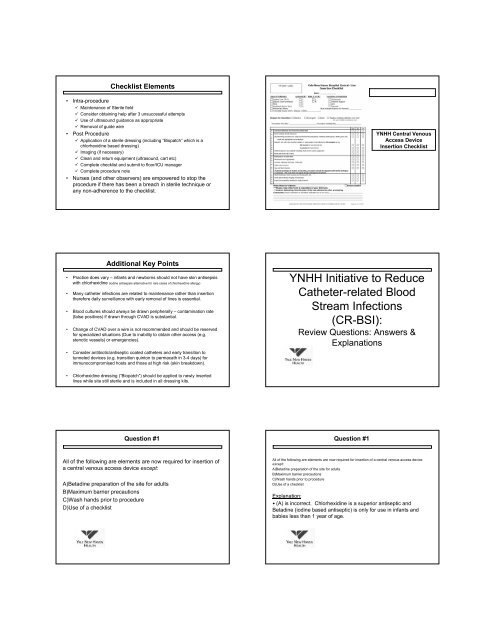



![Annual Report Donor Listings [pdf] - Yale-New Haven Hospital](https://img.yumpu.com/49673575/1/190x245/annual-report-donor-listings-pdf-yale-new-haven-hospital.jpg?quality=85)

